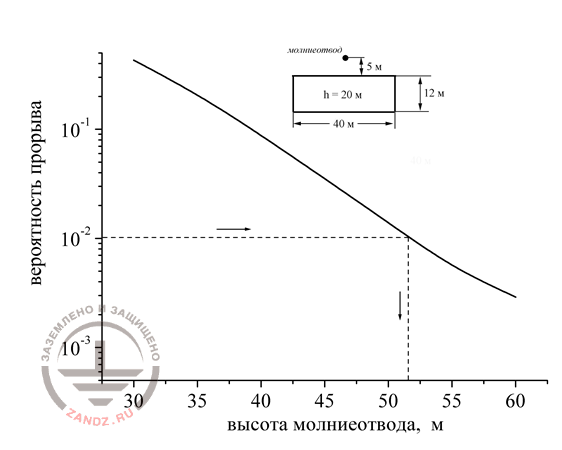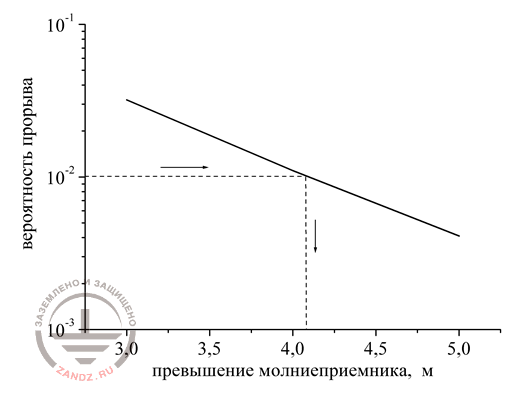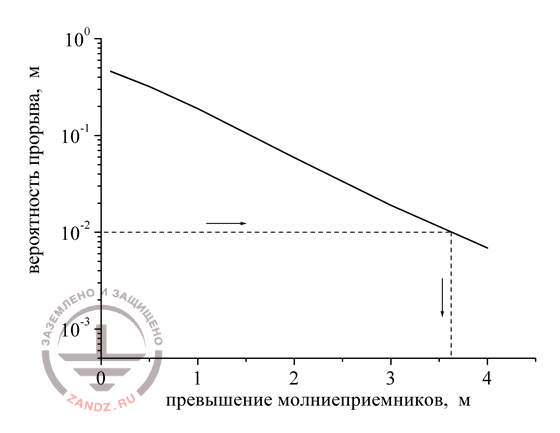The third part of the article "How to choose lightning rods after all?"
The method does not have any restrictions on the number and configuration of the lightning rods being installed and objects under protection. With its help it is possible to define the expected number of breahtrhoughs both into the complex of the protected objects and into any specific constructive element of the object. For that, it is enough to take only it as a protected object, and formally view all the rest structures as lightning rods. As concerns the ultimate height of on-ground structures, then there are no formal restrictions in its relation. However, it is necessary to consider that the method reflects the process of orientation of downward lightning and nM parameter, characterizing the density of lightning strikes on an undisturbed ground surface, refers to them. High-rise buildings exploitation experience on a lowland shows that starting from 200 m, the number of downward lightning almost stops to depend on this parameter and the summary number of strikes inceases only at the expense of upward charges, starting from the tops of the structures. For this reason, a well-developed method can be used without any restrictions for the objects up to 150-200 m high. Considering this circumstance, protection zones in the national regulatory document "Instruction on lightning protection of buildings, structures and industrial utilities IS-153-34.21.122-2003" are restricted by the height of 150 m. At that, the use of protection zones is recommended only for preliminary estimations of lightning rods' height, because their result turns out to be excessive even in relation of a single rod lightning rod in the majority of practically significant situations. For example, for the protection of a building 40x12 m, 20 m high with the reliability of 0,99 when estimating the protection zones a rod lightning rod 60 m high is required. If it is mounted on the distance of 5 m from the middle of the lengthwise wall. The calculation according to the statistical method, the results of which are shown in fig. 7 show that in reality, the height of the lightning rod can be reduced to 52 m.

Fig. 7
Calculation according to the statistical method of a probability of a lightning breakthrough to the building, protected by a single rod lightning rod
Вероятность прорыва – probability of a breakthrough
Высота молниеотвода - lightning rod height
The advantages of the statistical methodology become more visible in those cases where there is a tendency to reduce the height of lightning rods by increasing their number. Such a task has to be solved, if the greatest danger for the protected object comes from electromagnetic field of lightning, but not the contact of its channel with the constructive elements of the object. In such conditions, the use of a high lightning rod brings to a very significant increase of close lightning strikes, the current of which, flowing along the lightning rod, practically doesn't change its electromagnetic field in comparison to what the place would have at a direct lightning strike into the object. Not meeting problems at the calculation of a multi-rod system of lightning rods, the statistical method shows, that protection of the building from the previous example can be provided with the reliability of 0,99 having mounted 4 lightning rods on the roof at the corners of the building with the exceeding of about 4 m (fig. 8).

Fig. 8
Calculation according to the statistical method of a probability of a lightning breakthrough to the building, protected by 4 rod lightning rods
Вероятность прорыва – probability of a breakthrough
превышение молниеотвода - lightning rod exceeding
Such a protection system will take upon itself about 6 times less lightning strikes, than a single rod lightning rod 60 meters high, estimated according to the protection zones
The statistical method easily debunks the myth about a high efficiency of lightning protection mesh protective action with its minor exceeding above the roof. In calculation data in fig. 9, it was supposed that the mesh with the cells 10x12 m is placed on the roof of the already studied building. The probability of a breakthrough on the level 0,01 is achieved at its exceeding of 3,6 m, which is practically not different from the exceeding of rod lightning rods in the previous example (fig. 8). When the mesh was lifted above the roof to the recommended distance ~ 0,1 m, the probability of a lightning breakthrough approached 0,5, which indicates the practically complete liquidation of its protective action.

Fig. 9
Calculation according to the statistical method of a probability of a lightning breakthrough to the building, protected by lightning protection mesh with the cells 12x10 m
Вероятность прорыва – probability of a breakthrough
превышение молниеотвода - lightning rod exceeding
E. M. Bazelyan, DEA, professor
Energy Institute named after G.M. Krzyzanowski, Moscow
Read more "4. About the practice of choosing lightning rods"
See also:
- Useful materials for grounding and lightning protection designers
- Free webinars with the leading industry experts
- Real-life examples of grounding and lightning protection calculations
Related Articles:
 Lightning protection of residential and public buildings - answers to frequently asked questions in the design
Lightning protection of residential and public buildings - answers to frequently asked questions in the design
 6. How to do that?
6. How to do that?

